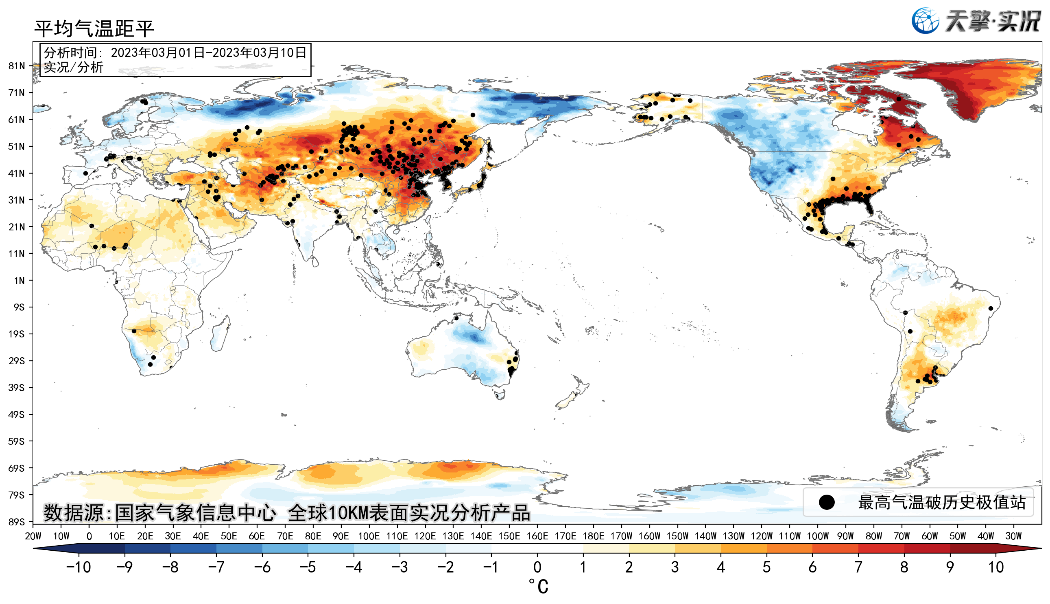Monthly Report of Global Disastrous Weather
March 2023

World Meteorological Centre Beijing
Abstract:
In March 2023, many types of severe weather were taken place in the world, including four large-scale cooling, which brought rain and snow weather to the United States, and two strong tornadoes struck the southern America in late March. In early March, Western Europe and Northern Europe continued to be cold, while the temperature in Asian was significantly higher. Frequent sand and dust weather in mid-to-late March affected Mongolia and China. Heavy rainfall or persistent heavy precipitation occurred in northern Brazil and northern Australia. Cyclone "Yaku" in the southeast Pacific Ocean brought extreme heavy rain to the Peruvian coast. Ultra-long typhoon "Freddy" made landfall in Mozambique again, and the wind and rain continued to affect Malawi, Mozambique and Madagascar, causing secondary disasters such as floods and landslides in some areas.
1. Overview of important global weather
In early March, the temperature in the northern Europe and northern Russia at high latitudes was significantly lower, while in most of Asia the temperature was significantly higher. The average temperature in Central Asia, Outer Mongolia, and northern China was about 10 ℃ higher than that in the same period of the year, and at multiple stations the average temperature exceeded the historical maximum during the same period. In middle and late March, the cold air event affected Asia many times, causing colder temperature tendency. In March, the cold air frequently attacked North America, resulting overall lower temperature. However, the subtropical high from the Atlantic to the Gulf of Mexico was unusually strong in the early and late March, resulting in significantly higher temperature in Mexico and the southeastern United States.
The temperature anomaly in the southern hemisphere was not as large as in the northern hemisphere, corresponding to seasonal changes, and the overall temperature showed a downward trend. The high temperature continued in northern Argentina, but gradually weakened in intensity, and the temperature in central and southern Africa was close to normal or high in early March, and gradually turned slightly lower than normal in the middle and late March.



Fig.1 Monthly 2m temperature anomaly in March 2023(unit:℃)
In March, the total precipitation was generally close to the same period of normal years. In northern hemisphere, the precipitation presented a gradually increasing seasonal variation, which was mainly distributed in Western Europe, Southern Europe, South Asia, East Asia, tropical islands in Southeast Asia, and the western and eastern United States. Precipitation in the Southern Hemisphere was mainly distributed in southern West Africa, East Africa and South Africa, northern Australia, New Zealand Island, and central and northern South America. The cumulative precipitation in the above countries and regions exceeded 100-300 mm, and the local precipitation exceeded 500 mm. Parts of northern Europe, central Europe, and the western and eastern United States continued to experience excessive precipitation, with precipitation exceeding the historical maximum for the same period. In the middle and late March, the precipitation in East Asia, East Africa and Brazil increased significantly compared with the early March.



Fig.2 Monthly total accumulated precipitation distribution in March 2023(unit: mm)
2. Severe weather Events
The ultra-long typhoon Freddy moved into the Mozambique Channel in early March and strengthened again into a tropical storm, and made landfall in central Mozambique again in the early morning of March 12 (typhoon level). Affected by it, the cumulative precipitation in south-central Mozambique and northern Malawi reached 300~500 mm, and the local area exceeded 600 mm, and secondary disasters such as floods, landslides and mudslides occurred in Malawi, Mozambique and Madagascar.
Since February, the temperature had been high, especially in early March, and most of Mongolia's precipitation was relatively low, so most of Mongolia's vegetation conditions were poor, especially in the western region. With the adjustment of the circulation pattern in mid-to-early March, the high-pressure ridge of the Ural Mountains developed, guiding the polar cold air along the east and middle roads into Mongolia and China. The cold air triggered the rapid development of Mongolian cyclones, thus resulting in three large-scale dust weather and local dust storms in southwest Mongolia.
In March, North America had frequent stormy weather processes, with four large-scale rain and snow weather processes, three of which severely affected California in the western United States and one seriously affected the northeastern United States. In addition, heavy snow and rain attack the central and northern, southern parts of the UK from 9 to 10 March, respectively, accompanied by strong winds. Bad weather caused road and rail closures and travel restrictions. After that, the cold weather continued for a week.
From 9 to 13 March, under the influence of Cyclone Yaku, many places along the northern and central coasts of Peru experienced heavy rainfall, and the precipitation in the northwest region was more than twice that of the same period of the year. Heavy rainfall causes secondary disasters such as floods and landslides.
3. Outlook
In the next two weeks, cold air activity affecting Asia is expected to remain more frequently, but the overall impact is northerly, with significantly lower temperature in Siberia and Outer Mongolia. The cold air affecting North America will be weakened, so the temperature will turn to be high. In addition, temperatures will be significantly higher in Northern Europe, South Asia and the Indochina Peninsula. The regions with the highest precipitation in the world are mainly located in southern Europe, the tropical islands of Southeast Asia, northwestern South America and southern Brazil, southeastern Australia and eastern Africa. In addition, attention is still needed for cyclone formation and development in the Indian Ocean and waters off Australia.
Editor: Zhou Ningfang, Li Xiaolan, Xie Jin, Mao Xu, Wang Qian, Zhang Tao
Any comments or inquiry on this report would be much appreciated. Please e-mail to wmc-bj@cma.gov.cn
World Meteorological Centre Beijing Website:
 京公网安备 11040102700102号
京公网安备 11040102700102号